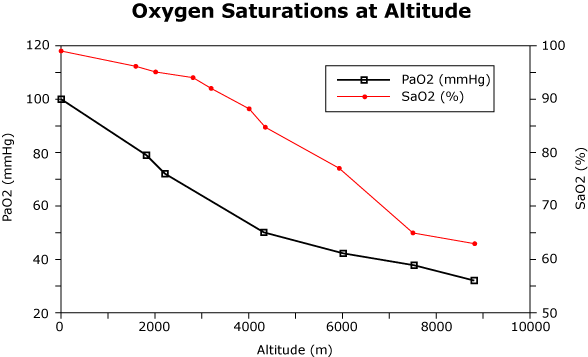Everything you should know about acclimatisation to altitude, acute mountain sickness and their counter-measures....
Everything you should know about acclimatisation to altitude, acute mountain sickness and their counter-measures.
Cases of severe acute mountain sickness are described in medical literature from altitudes as low as 2500m above sea level!
It has to be noted that ski regions, mountain huts, hiking trails and summits of the Zillertal Alps are at least 2500m above sea level. Usually you do not have to assume severe occurrences such as HACE(=high altitude cerebral edema) or HAPE(=high altitude pulmonary edema) as they appear in the Himalaya regions or South American Andes. But many visitors coming from the sea level suffer from the first signs of acute mountain sickness.
Acute mountain sickness is actually an accident, not a disease, because a healthy person can prevent it with appropiate knowledge and preparation.
Why does acute mountain sickness occur?
With increasing altitude the amount of oxygen in the air decreases overproportionally. Therefore - with increasing absolute altitude but constant altitude differences - you have to expect higher decreases of oxygen in your blood.

PaO2 - Sauerstoffpartialdruck in den Lungenbläschen (Alveolen) in [mmHg]
SaO2 - Sauerstoffsättigung des Kapillarblutes in den Alveolen in [%]
This kind of oxygen (SaO2) is important for the production of energy in our body. Thus our body reacts to the oxygen deficiency (Hypoxia) by increasing the breath- and heart-rate, thereby increasing the blood pressure and the production of red blood cells in the bone marrow. This act is called ADAPTATION. Normally it takes about five days. When the Adaptation is finished, the ACCLIMATISATION begins. It is characterised by the following symptoms: The rate of breath and heart beat as well as blood pressure decline. An increase of red blood cells and changes in biochemical processes in the lung and the musculature take place. Usually you can still benefit from the effect of Acclimatisation up to three months after returning to lower altitutudes. Various factors such as fever, overexertion, infections, alcohol or diseases can reduce these adaptation benefits considerably. Therefore you should pay attention to the prophylaxis of a common cold. Well-balanced nutrition and adequate vitamin supply are important aspects. We carry special vitamins for that need! We will happily advise you how to boost your immune system, in order to prevent a common cold.
If time is too short for your organism to adapt, oxygen deficieny will occur in all tissues from the brain to the muscles and an acute mountain sickness will occur.
Watch out for these first symptoms:
- Sickness
- Vomiting
- Headache
- Dizziness
- Very fast pulse when resting
- Impaired vision
- Shortage of breath when resting
- Coughing
- Absence of appetite and insomnia
- Irritibleness
- Unusual loss of strength
- Face- and lower leg edema
Acute Procedure:
If these initial symptoms do not disappear within one day of remaining at the same altitude, you have to descend by all means! In the Alps, it is often enough to descent a few 100 altitude meters until the symptoms disappear. If the descent is impossible or the symptoms worsen (e.g. persisting vomiting, hallucinations, breathing problems, coughing with ronchus and/or expectoration) you have to apply oxygen and treat the person under advise of an experienced doctor with following drugs:
Acetylsalicylsäure (z.B. Aspirin®):
Non-Steroidal Antirheumatic Drug, for adjuvant therapy if suffering from persistant headache from altitude. Also used for local frostbites.
Ibuprofen (z.B. Nurofen®):
Non-Steroidal Antirheumatic Drug, for adjuvant therapy if suffering from persistant headache from altitude.
Naproxen (z.B. Proxen®):
Non-Steroidal Antirheumatic Drug, for adjuvant therapy if suffering from persistant headache from altitude.
Acetazolamid (z.B. Diamox®):
Inhibitor of the Carboanhydrasis, which is diuretic and lowers the pulmonary-arterial pressure and intraocular pressure. Also used for altitude induced sleep apnoea. .
Dexamethason (z.B. Fortecortin®):
Glukocorticosteroid, which especially affects well the high altitude cerebral edema.
Nifedipin (z.B. Adalat®):
Calcium inhibitor, which is used to treat the high altitude pulmonary edema.
Sildenafil (z.B. Viagra®):
Inhibitor of the enzym Phosphodiesterase; used for pulmonary-arterial Hypertension. Currently not routinely used for high altitude pulmonary edema.
It is pointed out again that these drugs should only be given out by a doctor!
Prophylaxis of the Acute Mountain Sickness
- Take your time!
- Drink, drink, drink… roughly observe the colour and the amount of your urine. It should be at least 750ml a day.
- In altitudes above 2500m you should not sleep in places that are more than 300-500 altitude meters higher than the previous day, whereas in altitudes above 3000m the maximum change per day should be 250-300 altitude meters. During the day the ascent into higher regions is harmless as long as you spend spend the night on lower levels.
- At the University of Innsbruck sport scientist Prof. Martin Burtscher developed a method for predicting the development of Acute Mountain Sickness, which is published in the following abstract: Link


